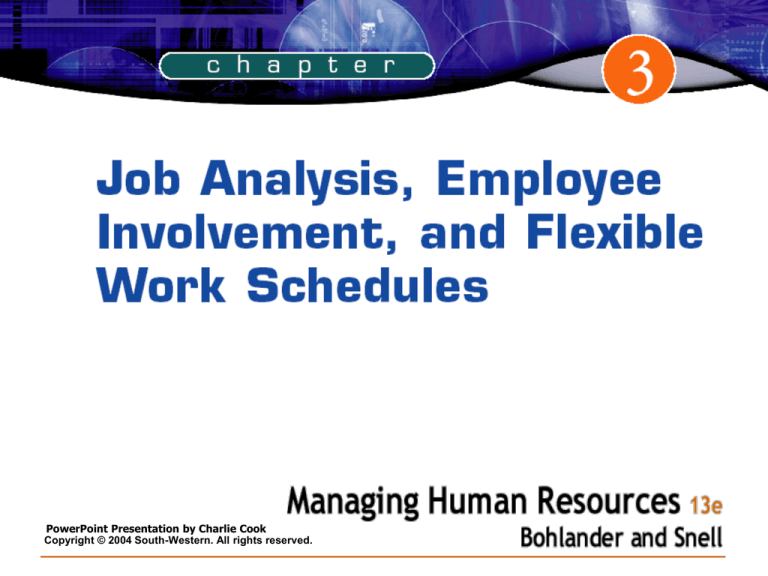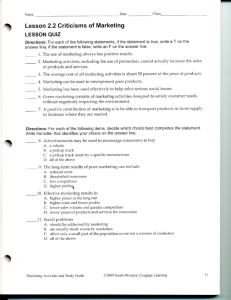
PowerPoint Presentation by Charlie Cook
Copyright © 2004 South-Western. All rights reserved.
Objectives
After studying this chapter, you should be able to:
1. Discuss the relationship between job requirements
and the performance of HRM functions.
2. Indicate the methods by which job analysis
typically is completed.
3. Identify and explain the various sections of job
descriptions.
4. Provide examples illustrating the various factors
that must be taken into account in designing a job.
5. Discuss the various job characteristics that motivate
employees.
Copyright © 2004 South-Western. All rights reserved.
3–2
Objectives (cont’d)
After studying this chapter, you should be able to:
6. Describe the different group techniques used to
maximize employee contributions.
7. Differentiate and explain the different adjustments in
work schedules.
Copyright © 2004 South-Western. All rights reserved.
3–3
What is a Job?
• Job
A group of related activities
and duties
Job
• Position
The different duties and
responsibilities performed
by only one employee
Job
Job
Job
• Job Family
A group of individual jobs
with similar characteristics
Copyright © 2004 South-Western. All rights reserved.
3–4
Job Requirements
• Job Specification
Statement of the needed knowledge, skills, and
abilities (KSAs) of the person who is to perform the
job
Since Griggs v Duke Power and the Civil Rights Act of
1991, job specifications used in selection must relate
specifically to the duties of the job.
• Job Description
Statement of the tasks, duties, and responsibilities
(TDRs) of a job to be performed
Copyright © 2004 South-Western. All rights reserved.
3–5
Relationship of Job Requirements
to Other HRM Functions
Job Requirements
Recruitment
Determine recruitment qualifications
Selection
Provide job duties and job
specifications for selection process
Performance
Appraisal
Provide performance criteria for
evaluating employees
Training and
Development
Determine training needs and develop
instructional programs
Compensation
Management
Provide basis for determining
employee’s rate of pay
Presentation Slide 3–1
Copyright © 2004 South-Western. All rights reserved.
3–6
Job Analysis
• Job Analysis
The process of obtaining information about jobs by
determining what the duties, tasks, or activities of jobs
are.
HR managers use the data to develop job descriptions
and job specifications that are the basis for employee
performance appraisal and development.
Copyright © 2004 South-Western. All rights reserved.
3–7
The Process
of Job
Analysis
Figure 3.1
Copyright © 2004 South-Western. All rights reserved.
3–8
Determining Job Requirements
Nature of:
Basis for:
Job Analysis
• What employee does
• Why employee does it
• How employee does it
• Determining job requirements
Job Description
• Summary statement of the job
• List of essential functions of the
job
• Employee orientation
• Employee instruction
• Disciplinary action
Job Specification
• Personal qualifications required
in terms of skills, education and
experience
Copyright © 2004 South-Western. All rights reserved.
• Recruitment
• Selection
• Development
Presentation Slide 3–2
3–9
Job Analysis and Essential Job Functions
• Essential Functions
Statements in the job description of job duties and
responsibilities that are critical for success on the job.
The purpose of essential functions is to match and
accommodate human capabilities to job requirements.
• A job function is essential if:
The position exists to perform the function.
A limited number of employees are available to
perform the function.
The function is specialized, requiring needed
expertise or abilities to complete the job.
Copyright © 2004 South-Western. All rights reserved.
3–10
Performing Job Analysis
1. Select jobs to study
2. Determine information to collect: Tasks,
responsibilities, skill requirements
3. Identify sources of data: Employees,
supervisors/managers
4. Methods of data collection: Interviews, questionnaires,
observation, diaries and records
5. Evaluate and verify data collection: Other employees,
supervisors/managers
6. Write job analysis report
Copyright © 2004 South-Western. All rights reserved.
Presentation Slide 3–3
3–11
Gathering Job Information
• Interviews
• Questionnaires
• Observation
• Diaries
Copyright © 2004 South-Western. All rights reserved.
3–12
Controlling the Accuracy of Job Information
• Factors influencing the accuracy of job
information
Self-reporting exaggerations and omissions by
employees and managers
Collecting information from a representative sample
of employees
Capturing all important job information
Length of job cycle exceeding observation period
Lack of access to job site for personal observation
Lack of familiarity with the tasks, duties, and
responsibilities of a job
Ongoing changes in the job
Copyright © 2004 South-Western. All rights reserved.
3–13
O*NET and Job Analysis
• Dictionary of Occupational Titles (DOT)
A systematic occupational classification structure
based on interrelationships of job tasks and
requirements.
Contains standardized and comprehensive
descriptions of twenty-thousand jobs.
• O*NET Database
A online database of all DOT occupations plus an
update of over 3,300 additional DOT occupations.
Data are collected and published continuously.
Copyright © 2004 South-Western. All rights reserved.
3–14
Popular Approaches to Job Analysis
Functional Job
Analysis
Position Analysis
Questionnaire
Critical Incident
Method
HRIS and Job
Analysis
Copyright © 2004 South-Western. All rights reserved.
3–15
Approaches to Job Analysis
• Functional Job Analysis (FJA)
Quantitative approach to job analysis that utilizes a
compiled inventory of the various functions or work
activities that can make up any job.
Assumes that each job involves three broad worker
functions: (1) data, (2) people, and (3) things.
Copyright © 2004 South-Western. All rights reserved.
3–16
Difficulty Levels of Worker Functions
DATA (4TH DIGIT)
PEOPLE (5TH DIGIT)
THINGS (6TH DIGIT)
0 Synthesizing
0 Mentoring
0 Setting up
1 Coordinating
1 Negotiating
1 Precision working
2 Analyzing
2 Instructing
2 Operating-controlling
3 Compiling
3 Supervising
3 Driving-operating*
4 Computing
4 Diverting
4 Manipulating
5 Copying
5 Persuading
5 Tending
6 Comparing
6 Speaking-signaling*
6 Feeding-offbearing*
7 Serving
7 Handling
8 Taking instructions—helping*
Source: U.S. Department of Labor, Employment and Training Administration, Revised
Handbook for Analyzing Jobs (Washington, DC: U.S. Government Printing Office, 1991), 5.
Copyright © 2004 South-Western. All rights reserved.
More
Less
*Hyphenated factors are single factors.
Figure 3.2
3–17
Approaches to Job Analysis
• Position Analysis Questionnaire (PAQ)
A copyrighted questionnaire that is used to determine
the degree to which different tasks are involved in
performing a particular job.
• Critical Incident Method
Job analysis method by which job tasks are identified
that are critical to job success.
• HRIS and Job Analysis
Human resource information systems (HRIS) help
automate the process of job analysis.
Copyright © 2004 South-Western. All rights reserved.
3–18
A Sample Page from the PAQ
Source: Position Analysis Questionnaire, copyright 1969, 1989 by Purdue
Research Foundation, West Lafayette, Ind. 47907. Reprinted with permission.
Copyright © 2004 South-Western. All rights reserved.
Figure 3.3
3–19
Preparing the Job Description
Interview
Questionnaire
Supervisor
Securing
consensus
Job
Analyst
Interview
Questionnaire
Observation
Employees
Combine and
reconcile data
Copyright © 2004 South-Western. All rights reserved.
Final
Draft
Tentative
draft
Presentation Slide 3–4
3–20
Key Elements of a Job Description
• Job Title
Indicates job duties and organizational level
• Job Identification
Distinguishes job from all other jobs
• Essential Functions (Job Duties)
Indicate responsibilities entailed and results to be
accomplished
• Job Specifications
Skills required to perform the job and physical
demands of the job
Copyright © 2004 South-Western. All rights reserved.
3–21
Job Descriptions
• Job Title
Provides status to the employee.
Indicates what the duties of the job entails.
Indicates the relative level occupied by its holder in
the organizational hierarchy.
Copyright © 2004 South-Western. All rights reserved.
3–22
Job Descriptions (cont’d)
• Job Identification Section
Departmental location of the job
Person to whom the jobholder reports
Date the job description was last revised
Payroll or code number
Number of employees performing the job
Number of employees in the department where the
job is located
O*NET code number.
“Statement of the Job”
Copyright © 2004 South-Western. All rights reserved.
3–23
Job Descriptions (cont’d)
• Job Duties, or Essential Functions, Section
Statements of job duties that:
Are arranged in order of importance that indicate the
weight, or value, of each duty; weight of a duty is gauged
by the percentage of time devoted to it.
Stress the responsibilities that duties entail and the
results to be accomplished.
Indicate the tools and equipment used by the employee
in performing the job.
Should comply with law by listing only the essential
functions of the job to be performed.
Copyright © 2004 South-Western. All rights reserved.
3–24
Job Descriptions (cont’d)
• Job Specifications Section
Personal qualifications an individual must possess in
order to perform the duties and responsibilities
The skills required to perform the job:
– Education or experience, specialized training, personal
traits or abilities, interpersonal skills or specific behavioral
attributes, and manual dexterities.
The physical demands of the job:
– Walking, standing, reaching, lifting, talking, and the
condition and hazards of the physical work environment
Copyright © 2004 South-Western. All rights reserved.
3–25
Problems with Job Descriptions
• If poorly written, they provide little guidance to
the jobholder.
• They are not always updated as job duties or
specifications change.
• They may violate the law by containing
specifications not related to job success.
• They can limit the scope of activities of the
jobholder, reducing organizational flexibility.
Copyright © 2004 South-Western. All rights reserved.
3–26
Writing Clear and Specific Job Descriptions
• Create statements that:
Are terse, direct, and simply worded; eliminate
unnecessary words or phrases.
Describe duties with a present-tense verb, the implied
subject being the employee performing the job.
Use “occasionally” to describe duties performed once
in a while and “may” for duties performed only by
some workers on the job.
State the specific performance requirements of a job
based on valid job-related criteria.
Copyright © 2004 South-Western. All rights reserved.
3–27
Job Design
• Job Design
An outgrowth of job analysis that improves jobs
through technological and human considerations in
order to enhance organization efficiency and
employee job satisfaction.
• Job Enrichment (Herzberg)
Enhancing a job by adding more meaningful tasks
and duties (vertical expansion) to make the work
more rewarding or satisfying.
Providing opportunities for achievement, recognition,
growth, responsibility, and performance.
Copyright © 2004 South-Western. All rights reserved.
3–28
Basis for Job Design
Copyright © 2004 South-Western. All rights reserved.
Figure 3.4
3–29
Job Enrichment Factors
• Increasing the level of difficulty and
responsibility of the job
• Allowing employees to retain more authority
and control over work outcomes
• Providing unit or individual job performance
reports directly to employees
• Adding new tasks to the job that require
training and growth
• Assigning individuals specific tasks, thus
enabling them to become experts
Copyright © 2004 South-Western. All rights reserved.
3–30
Job Characteristics
• Job Characteristics Model
(Hackman and Oldham)
Job design that purports that three psychological
states (experiencing meaningfulness of the work
performed, responsibility for work outcomes, and
knowledge of the results of the work performed) of a
jobholder result in improved work performance,
internal motivation, and lower absenteeism and
turnover.
Copyright © 2004 South-Western. All rights reserved.
3–31
Job Characteristics Model
• Job
Characteristics
Skill variety
Task identity
Task
significance
Autonomy
Feedback
• Psychological
States
Meaningfulness of
the work
performed
Responsibility for
work outcomes
Knowledge of the
results of the
work performed.
Presentation Slide 3–5
Copyright © 2004 South-Western. All rights reserved.
• Job
Outcomes
Improved work
performance
Increased
Internal
motivation
Lower
absenteeism
and turnover
3–32
Employee Empowerment
• Employee Empowerment
Granting employees power to initiate change, thereby
encouraging them to take charge of what they do
Organizational conditions favoring empowerment:
Participation and autonomy
Innovation and acceptance of risk-taking
Access to information
Accountability for results
Cultural openness to change
Copyright © 2004 South-Western. All rights reserved.
3–33
Industrial Engineering Considerations
• Industrial Engineering
A field of study concerned with analyzing work
methods and establishing time standards
• Ergonomics
An interdisciplinary approach to designing equipment
and systems that can be easily and efficiently used by
human beings
Copyright © 2004 South-Western. All rights reserved.
3–34
Designing Work for Group/Team
Contributions
• Employee Involvement Groups (EIs)
Groups of employees who meet to resolve problems
or offer suggestions for organizational improvement
Also known as “Quality Circles”
Success with EIs requires:
Comprehensive training for group members
Recognition of the group’s contributions
Continuing input and encouragement by management
Use of a participative/democratic leadership style
Copyright © 2004 South-Western. All rights reserved.
3–35
The Dynamics of Employee Involvement Groups
Source: Adapted from materials prepared by The Family and Relationship Center, 7946 Ivanhoe Avenue, La Jolla, CA 92037.
Copyright © 2004 South-Western. All rights reserved.
Figure 3.6
3–36
Creating Effective Employee Involvement
Groups
• Appoint an EI project manager.
• Appoint an advisory group (including managers) in order
to coordinate the process across departments.
• Recognize employees and EI groups that generate
ideas, regardless of whether the idea will be
implemented.
• Provide training to EI members.
Copyright © 2004 South-Western. All rights reserved.
Presentation Slide 3–6
3–37
Creating Effective Employee Involvement
Groups (cont’d)
• Give groups a recess or break from the process in order
to refresh members.
• Provide field trips to EI members so that they can better
understand the entire organizational function.
• Try natural work groups as well as the more traditional
heterogeneous EI composed from several work groups.
• Do not expect fundamental changes in the
organizational culture to result from EIs.
Copyright © 2004 South-Western. All rights reserved.
Presentation Slide 3–7
3–38
Employee Teams
• Employee Teams
An employee contributions technique whereby:
Work functions are structured for groups rather than for
individuals
Team members are given discretion in matters
traditionally considered management
prerogatives, such as process
improvements, product or
service development, and
individual work assignments.
Copyright © 2004 South-Western. All rights reserved.
3–39
Benefits of Employee Teams
• Increased integration of individual skills
• Better performance (quality and quantity)
solutions to unique and complex problems
• Reduced delivery time
• Reduced turnover and absenteeism
• Accomplishments among team members
Copyright © 2004 South-Western. All rights reserved.
3–40
How To Develop Team Synergy
Support
Focus on Quality
Listen and Clarify
SYNERGY
Consensus
Decision Making
Disagree
Constructively
Acceptance of
Member Skills
Copyright © 2004 South-Western. All rights reserved.
Presentation Slide 3–8
3–41
Teamwork and Synergy
• Synergy
Occurs when the interaction and outcome of team
members is greater than the sum of their individual
efforts.
Synergistic team member behavior characteristics:
Is supporting and inclusive
Listens and clarifies
Disagrees but remains nonjudgmental
Engages in consensus building
Is accepting of others
Is focused on quality and continuous improvement
Copyright © 2004 South-Western. All rights reserved.
3–42
Forms of Employee Teams
• Cross-Functional Teams
• Project Teams
• Self-Directed Teams
• Task Force Teams
• Process-Improvement Teams
• Virtual Teams
Copyright © 2004 South-Western. All rights reserved.
Figure 3.8
3–43
Forms of Employee Teams
• Cross-Functional Team
A group staffed with a mix of specialists (e.g.,
marketing, production, engineering) and formed to
accomplish a specific objective.
Cross-functional teams are based on assigned rather
than voluntary membership.
• Project Team
A group formed specifically to design a new product
or service. Members are assigned by management on
the basis of their ability to contribute to success.
The group normally disbands after task completion.
Copyright © 2004 South-Western. All rights reserved.
3–44
Forms of Employee Teams (cont’d)
• Self-Directed Team
Groups of highly trained individuals performing a set
of interdependent job tasks within a natural work unit.
Team members use consensus decision making to
perform work duties, solve problems, or deal with
internal or external customers.
• Task Force Team
A task force is formed by management to immediately
resolve a major problem.
The group is responsible for developing a long-term plan
for problem resolution that may include a charge for
implementing the solution proposed.
Copyright © 2004 South-Western. All rights reserved.
3–45
Forms of Employee Teams (cont’d)
• Process-Improvement Team
A group of experienced people from different
departments or functions and charged with improving
quality, decreasing waste, or enhancing productivity in
processes that affect all departments or functions
involved. Team members are normally appointed by
management.
• Virtual Team
A group with widely dispersed members linked
together through computer and telecommunications
technology.
Copyright © 2004 South-Western. All rights reserved.
3–46
Characteristics of Successful Teams
• Commitment to shared goals and objectives
• Motivated and energetic team members
• Open and honest communication
• Shared leadership
• Clear role assignments
• Climate of cooperation, collaboration, trust, and
accountability
• Recognition of conflict and its positive resolution
Copyright © 2004 South-Western. All rights reserved.
3–47
Flexible Work Schedules
• Compressed Workweek
Shortening the number of days in the workweek by
lengthening the number of hours worked per day.
Examples:
– The four-day, forty-hour week, generally referred to as
4/10 or 4/40. Employees work a four-day workweek, ten
hours a day.
– Reducing weekly hours to thirty-eight or thirty-six hours or
scheduling eighty hours over nine days (9/80), taking one
day off every other week.
Copyright © 2004 South-Western. All rights reserved.
3–48
Flexible Work Schedules
• Flextime
Working hours that permit employees the option of
choosing daily starting and quitting times, provided
that they work a set number of hours per day or week.
All employees are required to be present during a
designated “core period.”
Flexible hours reduce absenteeism and tardiness.
Copyright © 2004 South-Western. All rights reserved.
3–49
Flexible Work Schedules
• Job Sharing
The arrangement whereby two part-time employees
perform a job that otherwise would be held by one
full-time employee.
Job sharers work three days a week,“creating an
overlap day for extended face-to-face conferencing.”
• Telecommuting
The use of personal computers, networks, and other
communications technology such as fax machines to
do work in the home that is traditionally done in the
workplace.
Copyright © 2004 South-Western. All rights reserved.
3–50
Keys for Successful Telecommuting
• Identify jobs best suited to distance work.
• Select responsible employees.
• Establish employee feedback procedures and
performance review methods for evaluation.
• Establish formalized telecommuting procedures.
• Begin a formal training program.
• Keep telecommuters informed and “in the loop.”
• Recognize when telecommuting isn’t working.
Source: Adapted from “What Is the Future of Telework?” HRFocus 78, no. 3 (March 2001): 5–6.
Copyright © 2004 South-Western. All rights reserved.
Figure 3.7
3–51





